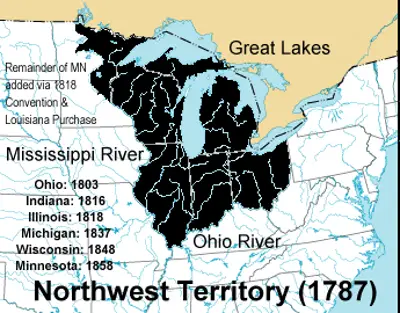The Northwest Ordinance
The Northwest Ordinance was a 1787 act of Congress that created the Northwest Territory. Also known as the Ordinance of 1787, it has as its official title "An Ordinance for the Government of the Territory of the Untied States North West of the River Ohio." The Northwest Territory included what is now Illinois, Indiana, Michigan, and Wisconsin, as well as part of Minnesota. In earlier days, this was called the Old Northwest. 
Native Americans had long lived in these lands. France in the 17th Century was the European power to claim ownership, followed not long afterward by Great Britain. Those two powers fought for supremacy in a nine-year-long war that Americans refer to as the French and Indian War, which ended in 1763 with a British victory that forced the French to vacate most of their North American lands. Disputes between the British government and American colonists led to the Revolutionary War, at the end of which ownership changed hands again, from Great Britain to the U.S. A handful of states claimed land in the territory, and disagreements ensued. Congress ended up keeping the peace by assuming ownership of the whole area. Thomas Jefferson had high hopes for the spread of democracy in the new territory, in the hope of a wave of individual farmers living on their own plots of land. This thinking drove the actions of a committee set up by Congress, which produced the Land Ordinance of 1784, setting a system for surveying the Northwest Territory in order to create the amount of land that an individual farm could afford. The committee envisioned dividing the territory along the lines of a grid and also drawing up boundary lines on a map without having to do the heavy lifting of physical surveying. The Land Ordinance of 1784 was not technically a law, but it did provide the basis for one, the Land Ordinance of 1785. Congress did pass this one, incorporating the grid system from the year before. This Ordinance set out a system for dividing the Old Northwest into townships, to be further divided into lots measuring one mile square, or 640 acres. The asking price was too high, and Congress had to settle for selling to a group of investors called the Ohio Company, for a much lower price. 
On July 13, 1787, Congress approved the Northwest Ordinance, which created the Northwest Territory. The Ordinance said that once the Northwest Territory reached a population of 5,000 free adult men, residents were able to form a territorial legislature and send a nonvoting member to Congress. The word "free" was key: The Northwest Ordinance prohibited territorial residents from owning slaves. (In a nod to the future Fugitive Slave Law, the Sixth Articles of the Ordinance also contained these words: "That any person escaping into the same, from whom labor or service is lawfully claimed in any one of the original States, such fugitive may be lawfully reclaimed and conveyed to the person claiming his or her labor or The Ordinance also gave Congress the power to create five states, eventually; first, they would be territories. Once a territory was formed, Congress would appoint a governor, a secretary, and three judges. Once a territory had a population of 60,000 free people, it could apply for statehood. Congress organized a Northwest Territory territorial legislature in 1799. The following year, the carving up of the territory began:
|
|
Social Studies for Kids
copyright 2002–2024
David White



 service as aforesaid"; in other words, people who lived in the Northwest Territory could not own slaves, but they also could not stop slaveowners from states that did allow slavery from seizing runaways who had sought freedom in the Northwest Territory.) The Ordinance also guaranteed the territories' residents the right to own property, the right to trial by jury, and the right to freedom of religion. Most importantly for many settlers, the Ordinance guaranteed a bill of rights. A wave of settlement followed.
service as aforesaid"; in other words, people who lived in the Northwest Territory could not own slaves, but they also could not stop slaveowners from states that did allow slavery from seizing runaways who had sought freedom in the Northwest Territory.) The Ordinance also guaranteed the territories' residents the right to own property, the right to trial by jury, and the right to freedom of religion. Most importantly for many settlers, the Ordinance guaranteed a bill of rights. A wave of settlement followed.
